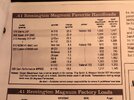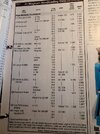dredd
Member
Ref.
41 Remington Magnum
Ruger NMBH
215/gr LSWC
Does anyone know of any other Published Sources besides Hodgdon?
They list one load that uses AA#9, which I'll already be using to load the Hornady 210/gr XTP's.
Manuals in hand are Hornady, Lyman and Sierra. (No Help on this bullet)
I'm curious if there are other powder options for this particular bullet.
I am not opposed to purchasing another manual.
For those that will ask why this bullet?
I can get these Hi-Tek Coated for $0.132/ea delivered.
Thanks!
Dredd
41 Remington Magnum
Ruger NMBH
215/gr LSWC
Does anyone know of any other Published Sources besides Hodgdon?
They list one load that uses AA#9, which I'll already be using to load the Hornady 210/gr XTP's.
Manuals in hand are Hornady, Lyman and Sierra. (No Help on this bullet)
I'm curious if there are other powder options for this particular bullet.
I am not opposed to purchasing another manual.
For those that will ask why this bullet?
I can get these Hi-Tek Coated for $0.132/ea delivered.
Thanks!
Dredd



